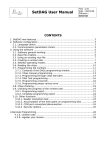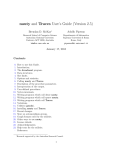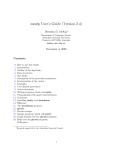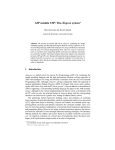Download Exploiting Orbits in Symmetric ILP
Transcript
Mathematical Programming manuscript No. (will be inserted by the editor) François Margot Exploiting Orbits in Symmetric ILP February, 2003 Abstract. This paper describes components of a branch-and-cut algorithm for solving integer linear programs having a large symmetry group. It describes an isomorphism pruning algorithm and variable setting procedures using orbits of the symmetry group. Pruning and orbit computations are performed by backtracking procedures using a Schreier-Sims table for representing the symmetry group. Applications to hard set covering problems, generation of covering designs and error correcting codes are given. Key words. Branch-and-cut – isomorphism pruning – symmetry 1. Introduction An integer linear program (ILP) is symmetric if its variables can be permuted without changing the structure of the problem. Symmetric ILPs frequently appear when formulating classical problems in combinatorics or optimization (graph coloring problem, scheduling of jobs on parallel identical machines, covering design problems, code construction; see [31] for additional real world examples). Even for relatively modestly sized problems, ILPs with large symmetry groups are difficult to solve using traditional branch-and-bound or branch-and-cut algorithms. (We assume that the reader is familiar with these procedures, as excellent introductions can be found in [10,30,32,33]). The trouble comes from the fact that many subproblems in the enumeration tree are isomorphic, forcing a wasteful duplication of effort. One way to deal with the symmetry is to try to remove or reduce it by fixing variables and adding inequalities cutting part of the feasible region, while guaranteeing that an optimal solution of the original problem is still feasible [31]. While this is sometimes an efficient approach, it usually involves empirical experimentation, each problem requiring a new study. The approach followed in this paper, along the lines of [23], is to deal with the symmetry by using the symmetry group of the problem to fix or set variables, to generate cuts and to prune the enumeration tree. The symmetry group is assumed to be part of the François Margot: Department of Mathematics, University of Kentucky, Lexington, KY 405060027, e-mail: [email protected] Mathematics Subject Classification (1991): 90C10, 90C27, 90C57 2 François Margot input. If the symmetry group is not completely known, any of its subgroups can be used. Alternatively, software computing the automorphism group of graphs (for example nauty [26]) can be used to generate the symmetry group from the ILP formulation. In [23], an isomorphism pruning algorithm using the symmetry group for a branch-and-cut algorithm was described. One of the main drawbacks of that algorithm is that the branching variable cannot be chosen freely, but always has to be the non-fixed variable with smallest index. In this paper, a modification of the algorithm allows for a more flexible rule to pick the branching variable, called ranked branching rule. It also introduces strict setting algorithms that can be used to set variables to 0 or 1 without conflicting with the isomorphism pruning. Section 3 defines the ranked branching rule and describes its associated pruning algorithm. Section 4 defines the strict setting algorithms and show how to use orbits of subgroups of G to set additional variables, an operation called orbit setting. Section 5 describes the strong branching procedure and the corresponding strict setting algorithm. Section 6 briefly presents basic group algorithms and data structures. Finally, Section 7 presents a comparison between several branch-and-cut algorithms to illustrate the effect of two strict setting algorithms when coupled (or not) with orbit setting. The test problems come from three types of applications: set covering problems from Steiner triple systems, covering designs, and error correcting codes. 2. Preliminaries Let Π n be the set of all permutations of the ground set I n = {1, . . . , n}. Π n is known as the symmetric group of I n . A permutation in Π n is represented by an n-vector π, with π[i] being the image of i under π. If v is an n-vector and π ∈ Π n , let w = π(v) denote the vector w obtained by permuting the coordinates of v according to π, i.e., w[π[i]] = v[i] for all i ∈ I n . We consider an integer linear program (ILP) of the form min cT x s.t. Ax ≥ b, (1) x ∈ {0, 1}n , where A is an m × n matrix. Without loss of generality, we also assume that the entries in A, b, and c are all integers. For a permutation π of the n variables and a permutation σ of the m rows of A let A(π, σ) be the matrix obtained from A by permuting its columns according to π and its rows according to σ. Let G = {π |π(c) = c and there exists σ s.t. σ(b) = b, A(π, σ) = A} . Exploiting Orbits in Symmetric ILP 3 Clearly, G is a permutation group of I n . Moreover, for π ∈ G, a point x̄ is feasible (resp. optimal) for the linear relaxation of ILP (1) if and only if π(x̄) is feasible (resp. optimal) for that ILP. Hence, G is a symmetry group of the feasible (and of the optimal) set of the ILP. Let S ⊆ I n . To simplify the notation, we make no difference between a set S and its characteristic vector and sets containing a single element e are written simply e instead of {e}. The orbit of S under G is orb(S, G) = {S ′ ⊆ I n | S ′ = g(S) for some g ∈ G} . The stabilizer of S in G is the subgroup of G given by: stab(S, G) = {g ∈ G | g(S) = S} . For 1 ≤ a ≤ b ≤ n, we write v[a..b] for the entries {v[a], v[a + 1], . . . , v[b]} of v as an unordered set. If g1 , . . . , gk are k permutations of I n , the permutation g = g1 ·. . .·gk is obtained by applying the permutations from right to left, i.e g(v) = g1 (g2 (. . . (gk (v)) . . .)) for any n-vector v. The proposed branch-and-cut algorithm will branch by fixing the value of one variable xj to 0 or 1. We make a difference between a variable fixed to 0 or 1 and a variable set to 0 or 1: A variable is fixed to a value if this is the result of a branching operation; it is set to a value if, for some reason other than a branching decision (e.g. reduced cost fixing, logical implications), the variable must take that particular value. Let a be a node of the branch-and-cut enumeration tree. We denote by F0a (resp. F1a ) the set of indices of variables fixed to 0 (resp. to 1) at a and N a for the set of indices of variables that are not fixed to 0 or 1 at a. We use S0a (resp. S1a ) for the set of indices of variables set to 0 (resp. to 1) at a. Note that S0a ∪ S1a ⊆ N a . 3. Ranked Branching Rule Let a and b be two nodes of the enumeration tree of a branch-and-cut algorithm. The subproblems associated with nodes a and b of the branch-and-cut are isomorphic if there exists a permutation g ∈ G, such that g(Fka ) = Fkb for k = 0, 1. Using this definition to prune nodes is difficult for two reasons: First, for a given pair of nodes a, b, deciding if a suitable permutation g ∈ G exists is not easy. Second, this decision problem would have to be solved for a large number of pairs of nodes. The goal of this section is to present a practical isomorphism 4 François Margot pruning algorithm. One advantage of the proposed algorithm is that it works with a single node a of the enumeration tree instead of a pair of nodes. This is a very valuable property, as storing nodes that have been already explored is then unnecessary. However, to achieve this, we need to restrict the choice of the branching variable. We then define one representative of each class of isomorphic subproblems, guaranteeing that pruning all nodes that are not representatives is valid. The proof of the later is the main result of this section. In [23], a simple branching rule, called minimum index branching, was used. Unfortunately, this rule is very inflexible: At node a, the branching variable has to be xf where f is the minimum index in N a (even if the value of xf in the current solution of the LP relaxation is 0 or 1). This section presents a relaxation of the rule, leaving more latitude for picking the branching variable at the cost of maintaining a vector R of integers, the rank vector, indicating the order in which the variables have been used as branching variables: At the beginning, R[i] = n + 1 for i = 1, . . . , n and r = 0. If variable xf is chosen for branching and R[f ] = n + 1, then R[f ] is set to r + 1 and r is increased by one. Note that both R and r are global variables (i.e., the same R and r are in use at each node of the enumeration tree) and that r is never decreased during the whole enumeration. The rule to select the branching variable xf at a, called ranked branching rule, is then the following: (i) If there exists j ∈ N a with R[j] < n + 1, then f = arg min {R[j] | j ∈ N a }. (ii) Otherwise, choose freely any index f ∈ N a . It follows that if each variable has been used at least once as a branching variable, the resulting rank vector R is a permutation of I n . The branching rule of [23] is obtained by always choosing the minimum index in N a in step (ii) above. Note that a variable i ∈ Ska for k = 0 or k = 1, might be the chosen branching variable. Then the rank vector is updated, a unique son b is created (since the other son could be pruned by infeasibility), and variable i becomes one of the fixed variables. In the remainder of the paper, we consider a branch-and-cut using a ranked branching rule. The rank vector R at the start of the processing of node a is denoted by Ra . Ra depends on the enumeration strategy, but the results given below are valid for any enumeration strategy. Let J = {j1 , . . . , jp } be an unordered multiset of I n+1 . Let J¯ be the ordered multiset obtained from J by ordering its elements in non-decreasing order. Given two multisets J1 , J2 in I n+1 , we write J1 J2 (resp. J1 ≺ J2 ) if J¯1 is lexicographically smaller or equal to J¯2 (resp. lexicographically strictly smaller than J¯2 ). Exploiting Orbits in Symmetric ILP 5 For a given rank vector R, a set J is a representative of the sets in its orbit under G if its rank R(J) := {R[j] | j ∈ J} is lexicographically minimum among the sets in its orbit under G, i.e., R(J) R(g(J)) ∀ g ∈ G. Notice that, for any rank vector R, there is at least one representative in the orbit of J and, possibly, more than one. Lemma 1. Let R1 and R2 be two rank vectors obtained during a branch-and-cut using a ranked branching rule and assume that R2 is obtained after R1 . Then (i) if J is not a representative with respect to R1 then J is not a representative with respect to R2 . (ii) if J is a representative with respect to R1 and all the entries in R(J) are strictly smaller than n + 1 then J is the unique representative of its orbit with respect to R1 . (iii) if J is a representative with respect to R1 and all the entries in R(J) are strictly smaller than n + 1 then J is also a representative with respect to R2 . Proof. (i): Let g ∈ G such that R1 (g(J)) ≺ R1 (J) and let p = |J|. Let R1 (J) be the ordered set (a1 , a2 , . . . , ap ), R2 (J) be the ordered set (a′1 , a′2 , . . . , a′p ), R1 (g(J)) be the ordered set (b1 , b2 , . . . , bp ) and R2 (g(J)) be the ordered set (b′1 , b′2 , . . . , b′p ). Let k be the index such that ai = bi for i = 1, . . . , k − 1 and bk < ak . Then bk < n + 1, implying that ai = a′i for i = 1, . . . , k − 1, a′k > bk and bi = b′i for i = 1, . . . , k. It follows that R2 (g(J)) ≺ R2 (J). (ii): Let J ′ be a set in the orbit of J under G. If R1 (J ′ ) = R1 (J) then J ′ = J as R1 is a bijection between J and R1 (J). (iii): The orbit of J under G has at least one representative with respect to R2 . Since, by (ii), J is the unique representative with respect to R1 , (i) implies the result. ⊓ ⊔ The following property is crucial for the validity of the pruning: Lemma 2. Let J ⊆ I n be a representative under G with respect to rank vector R. Let J ′ := J − j with j ∈ arg max {R[i] | i ∈ J}. Then J ′ is also a representative with respect to R. Proof. If J ′ is not a representative, then there exists g ∈ G such that R(g(J ′ )) ≺ R(J ′ ). Then R(g(J)) ≺ R(J), a contradiction. ⊓ ⊔ Consider the following isomorphism pruning to be applied at node a of the enumeration tree of a branch-and-cut using a ranked branching rule: If F1a is not 6 François Margot a representative with respect to Ra , then prune node a. (Node a is said to be pruned by isomorphism for short.) Remark 1. This isomorphism pruning introduces an asymmetry between variables fixed to 1 and those fixed to 0. It would be of course possible to define the representative using F0a instead of F1a , with similar results. Note however that pruning nodes where at least one of F0a and F1a is not a representative with respect to Ra would not work. To simplify the following, assume that the branching variable is chosen according to the minimum index rule, implying that R is the identity permutation. Consider the group generated by the permutation (2, 3, 1)T , and suppose that the optimal solution of the ILP (1) is obtained at node a when two of the variables have value 1 and the remaining one has value 0. Then F1a is a representative if and only if F1a = {1, 2}, and F0a is a representative if and only if F0a = {1}. Since F1a and F0a are always disjoint, a would be pruned by the isomorphism test working with both F1a and F0a and all nodes containing the optimal solution would be pruned. One way to work with both F1a and F0a would be to say that node a is not pruned if F1a is a representative and that F0a is lexicographically minimal in its orbit under stab(F1a , G). But this results in pruning exactly the same nodes as the proposed isomorphism pruning test, as F0a is “filling the gaps” between elements in F1a and F1a ∪F0a = {1, 2, . . . , k} for some k, showing that F0a is always lexicographically minimal in the considered orbit. ⊓ ⊔ Let B be a branch-and-cut using a ranked branching rule, isomorphism pruning, and a particular enumeration strategy. Let T be the enumeration tree of B, assuming that nodes are pruned only by isomorphism pruning or when the LP relaxation of the corresponding ILP is infeasible. This implies that even in the case where the linear relaxation associated with node a has an integer optimal solution, B continues to branch. Pruned nodes are not included in T . Let B ′ be the branch-and-cut obtained from B by dropping isomorphism pruning, but enumerating the nodes in the same order as B, the remaining nodes being processed arbitrarily after that. Let T ′ be the enumeration tree of B ′ , assuming that nodes are pruned only by infeasibility. Pruned nodes are not included in T ′ . Note that T ⊆ T ′ . Lemma 3. Let R be the rank vector obtained at the end of the enumeration for B. Then (i) If a ∈ T ′ − T then F1a is not a representative of its orbit with respect to R; (ii) If a ∈ T then F1a is the unique representative of its orbit with respect to R; (iii) B and B ′ return the same optimal value. Proof. (i): If a ∈ T ′ − T then a node b on the path between the root of T ′ and a is pruned by isomorphism. Then F1b is not a representative with respect Exploiting Orbits in Symmetric ILP 7 to Rb , and thus, by Lemma 1 (i), it is not a representative with respect to R. By definition of a ranked branching rule, we have, for all i ∈ F1a − Fb1 , that R[i] > max {R[j]|j ∈ Fb1 }. Then, by Lemma 2, F1a cannot be a representative with respect to R. (ii): As a was not pruned by isomorphism, F1a is a representative with respect to Ra . According to the rule for updating the rank vector during the enumeration, we have that R[i] < n + 1 for all i ∈ F1a . By Lemma 1 (ii) and (iii), F1a is the unique representative with respect to R. (iii): Let a be a node of T ′ for which F1a is the characteristic vector of an optimal solution to ILP (1) and such that F0a = I n − F1a . A representative of the orbit of F1a under G with respect to R is a set F ∗ , and, by (i) and (ii), there is a node b ∈ T with F1b = F ∗ and F0b = I n − F ∗ . As B processes node b at some point, B yields the same optimal value as the one returned by B ′ . ⊓ ⊔ Lemma 3 shows the validity of the isomorphism pruning. It should then be obvious that usual techniques such as cutting planes and pruning by bounds can be added to B, keeping a branch-and-cut returning an optimal solution of the problem. On the other hand, setting variables to 0 or 1 requires some care, as explained in the next section. 4. Setting variables This section shows how to modify standard techniques for setting variables to 0 or 1 (e.g. reduced cost fixing) when coupled with isomorphism pruning. This motivates the definition of a strict setting algorithm. Then new results allowing for the setting of additional variables are presented. A consequence of these results is that, at node a, all variables in the same orbit of stab(F1a , G) can be set simultaneously to k as soon as it is known that one of them can be set to k by a strict setting algorithm working under symmetry, for k = 0, 1. Let a be a node of the enumeration tree and let z ∗ be the value of the best known feasible solution to ILP (1) when processing node a. Let ILP a denote the ILP at node a, i.e., ILP (1) where variables in Fka ∪ Ska take value k, for k = 0, 1. It is sometimes possible to identify variables that may be set to 0 or 1 without affecting the optimal solution returned by a branch-and-cut. Usually, if it is possible to show that there exists an optimal solution x̄ of ILP a with x̄i = k, for k = 0 or k = 1, then it is valid to set that variable to k at a. When using a branch-and-cut with isomorphism pruning, however, this is not true anymore, as the node corresponding to x̄ might be pruned by isomorphism and the representative of its orbit might have xi = 1 − k. To avoid this, it is necessary to use a strict setting algorithm. This is a procedure used to identify variables that must be 0 (resp. 1) in every optimal solution of ILP (1) having 8 François Margot value less than z ∗ that is feasible for ILP a . The procedure then includes the variables in S0a (resp. S1a ) and sets them to 0 (resp. 1). If the algorithm wants to set a variable in Fka ∪ Ska to the value (1 − k) for k = 0 or k = 1, ILP a is infeasible and a is pruned. For simplicity, this observation is implicit in the remainder of the paper. For what follows it is essential that the strict setting algorithm works under symmetry: If the setting algorithm is able to set variable xi in ILP a then, for any g ∈ G, it is able to set variable xg(i) in the ILP obtained from ILP a by permuting the variables according to g. This essentially prevents the setting algorithm to work based on conditions linked to the isomorphism pruning, but allows for traditional setting procedures. In the remainder of the paper, we only consider strict setting algorithms working under symmetry. As an example of a strict setting algorithm, consider the usual reduced cost fixing procedure: Let c̄ ≥ 0 be the reduced costs of the optimal solution of the linear relaxation of ILP a having value z. If xi is non basic at its lower bound and z + c̄i ≥ z ∗ then xi = 0 in every feasible solution of ILP a with value better than z ∗ . (A similar test can be used for a non basic variable at its upper bound). Since we assume that c is integer, it is valid to replace the condition by the stronger z + c̄i > z ∗ − 1. We consider a branch-and-cut B using isomorphism pruning, a ranked branching strategy and a strict setting algorithm. Let T be the nodes in the enumeration tree of B that are not pruned by infeasibility or isomorphism. For a ∈ T , let T a be the subtree of T rooted at a. A feasible leaf of T a is a leaf of T a where all variables are fixed to 0 or 1. A solution in T a is a solution x corresponding to a feasible leaf of T a . An optimal solution in T a is a solution in T a that is optimal for ILP (1). The next lemma shows that it is possible to set additional variables to 0, based on the variables fixed to 0 at ancestors nodes. The idea is that if a variable was fixed to 0 at an ancestor d, then either F1d ∪ {i} is not a representative or the nodes f with F1f = F1d ∪ {i} are explored in the other subtree in the sons of d. Coupling this observation with some permutations in G, we get the following: Lemma 4. Let a ∈ T and let d be an ancestor of a in T . Let g ∈ G such that g(F1d ) ⊆ F1a ∪ S1a and let i ∈ F0d . Then no solution x in T a has xg(i) = 1. Proof. Assume that a feasible leaf b of T a has g(i) ∈ F1b . As g(F1d ) ⊆ F1a ∪ S1a ⊆ F1b , we have that g(F1d ) ∪ g(i) ⊆ F1b and thus F1b − F1d 6= ∅. Moreover, as a ranked branching rule is used and as i is fixed at d, Rd (i) < min {Rd (j) | j ∈ F1b − F1d }. As g −1 (g(F1d )∪g(i)) = F1d ∪i and Rd (F1d ∪i) ≺ Rd (F1b ), F1b is not a representative with respect to Rd . Lemma 1 (i) and Lemma 3 (ii) then show that b 6∈ T , a contradiction. ⊓ ⊔ Exploiting Orbits in Symmetric ILP 9 In situations were the strict setting algorithm is an expensive operation, it might be faster to use it only at a subset of the nodes of the enumeration tree. At other nodes, it is possible to use the following result to draw on the knowledge of fixed and set variables at other nodes in the tree. Note also that in certain cases, the strict setting algorithm works with an outside hint and that different conclusions might be obtained with different hints. (For example, for the reduced cost fixing procedure with degenerate LPs, two different optimal LP bases might yield different groups of variables to set to 0 or 1.) Lemma 5. Let z ∗ be the value of the best known feasible solution of ILP (1) while processing node a ∈ T and let d be a node of T . Let g ∈ G such that g(F0d ) ⊆ F0a ∪ S0a and g(F1d ) ⊆ F1a ∪ S1a . Then no optimal solution x in T a with value better than z ∗ has xg(i) = 1 for i ∈ S0d or xg(i) = 0 for i ∈ S1d . Proof. Assume that the indices in S0d ∪ S1d = {i1 , . . . , ip } are ordered according to the order in which the setting algorithm proved that these variables could be set. Let b(ik ) be the ancestor of d in T at which variable xik was set, for b(i ) b(i ) k = 1, . . . , p. Note that F0 k ⊆ F0d and F1 k ⊆ F1d . We prove by induction on k that xg(ik ) satisfies the statement. For k = 1, observe that a problem isomorphic to ILP b(i1 ) is obtained from ILP b(i ) (1) by assigning the value 0 to all variables in g(F0 1 ) and the value 1 to those in b(i1 ) g(F1 ). The choice of g implies that all these variables have the corresponding values in ILP a . It follows that the setting algorithm applied at node a can prove that xg(i1 ) satisfies the statement. The reasoning for k > 1 is similar, since a problem isomorphic to ILP b(ik ) is b(i ) obtained from ILP (1) by assigning the value 0 to all variables in g(F0 k ) and b(i ) the value 1 to those in g(F1 k ). Moreover, when the setting algorithm was used at b(ik ) to prove that xik could be set, the other variables already set had indices in {i1 , . . . , ik−1 }. Since all variables in xg(iq ) for 1 ≤ q ≤ k − 1 are set to the proper value in ILP a , and thus the strict setting algorithm on ILP a can prove that xg(ik ) can be set too. ⊓ ⊔ One difficulty in using Lemma 4 or Lemma 5 to set variables to 0 or 1 is computing the set G∗ of all g ∈ G satisfying the statement. For given nodes a and d, this set has no nice property and might not be a subgroup of G. Note however, that there is no need to compute the whole set G∗ as the results remain valid even if setting is done only for a subset of G∗ . The following corollaries are easier to use, albeit weaker than the Lemma. Corollary 1. Let i ∈ F0a . Then all the variables in orb(i, stab(F1a , G)) may be set to 0 in ILP a . 10 François Margot Proof. This is Lemma 4 for d = a and g ∈ stab(F1a , G), i.e., g satisfying g(F1a ) = F1a . ⊓ ⊔ Corollary 2. For i ∈ F0a ∪ S0a , all the variables in orb(i, stab(F1a , G)) can be set to 0 in ILP a . For i ∈ S1a , all the variables in orb(i, stab(F1a , G)) can be set to 1 in ILP a . Proof. For i ∈ F0a , the result is Corollary 1. After setting these variables to 0, we have g(F0a ) ⊆ F0a ∪ S0a . Then, for i ∈ S0a ∪ S1a , the result is Lemma 5 for d = a and g ∈ stab(F1a , G). ⊓ ⊔ Consider the following operations at node a ∈ T with rank vector Ra , called an orbit setting. Let set alg(a) be the strict setting algorithm used at node a with variables in F0a ∪ S0a having value 0 and variables in F1a ∪ S1a having value 1: (i) Compute all orbits in stab(F1a , G). (ii) For each i ∈ S1a , set to 1 all variables in orb(i, stab(F1a , G)) and update S1a accordingly. For each i ∈ F0a ∪ S0a , set to 0 all variables in orb(i, stab(F1a , G)) and update S0a accordingly. (iii) If additional variables can be set by set alg(a) update S0a and S1a accordingly and go to (ii). (iv) If N a = ∅ then return n + 1 and stop. (v) Let xf be the variable that would be chosen as the branching variable, according to the ranked branching rule. If F1a ∪ f is not a representative with respect to Ra , then set to 0 all variables in orb(f, stab(F1a , G)), update S0a accordingly and go to (ii). Otherwise, update Ra , return f and stop. The output of the orbit setting is the value f in (v) for which F1a ∪ f is a representative, or n + 1 if no such f exists. The validity of the orbit setting should be clear. Step (ii) is an application of Corollary 2 and the correctness of Step (v) follows from Lemma 1 (i) and Corollary 2. It remains to show how to compute orbits in stab(F1a , G) and how to test if a set is a representative or not. This will be covered in Section 6. If orbit setting is used, the operations performed at node a are: f := orbit setting at a; Repeat until a criterion is met solve the LP relaxation of ILP a ; generate cuts; If f < n + 1 then create two sons of a by fixing xf to 0 or 1; Exploiting Orbits in Symmetric ILP 11 It would of course be possible to apply the orbit setting a second time after cuts have been generated, but the differences are likely to be minimal. If orbit setting is not used, the branching index f is obtained by repeated application of step (v) of the orbit setting, skipping the setting of variables in orb(f, stab(F1a , G)) when F1a ∪ f is not a representative with respect to Ra . 5. Strong Branching The selection of the branching variable is a crucial component of an efficient branch-and-cut. While a rule of thumb can usually be devised for a particular problem, a universal rule is more elusive. For hard problems, where reducing the size of the enumeration tree is particularly important, the most successful procedure is probably strong branching: A list of candidate branching variables is built and, for each variable in the list, the LP relaxation of the two sons that would be created if the variable was selected is solved. The final choice of the variable is then based on the different values of the LP relaxations. Usually the LP is not solved to optimality, as only a fixed number of iterations of the dual simplex algorithms are performed. The maximum size of the candidate list is typically small. In the implemented algorithms, the LP is solved to optimality and the size of the candidate list is at most 10. (See [10] for more background on strong branching.) After performing an orbit setting at node a of the enumeration tree, the orbits of stab(F1a , G) partition N a into “equivalent” variables: If a variable is set to k, then so are all variables in its orbit. If a variable is not set, then none of the variables in its orbit is set. In the latter case, let i and j be two variables in the same orbit. As there exists g ∈ stab(F1a , G) such that g(i) = j, g(F1a ) = F1a , g(S1a ) = S1a , and f (F0a ∪ S0a ) = F0a ∪ S0a , including both i and j in the candidate list for strong branching is useless, as the resulting LPs for the potential sons will have exactly the same optimal values. If i (resp. j) can be set then the orbit setting will set j (resp. i) too. It follows that the strong branching candidate list needs to include not more than one variable from each orbit of stab(F1a , G). Note that the situation is different for the setting algorithm based on reduced costs: Since the calculations are done with respect to one particular optimal base, it is possible that the algorithm is able to set i but not j. A side result of the strong branching calculations is the occasional setting of some variables: Let xi be a candidate for strong branching. If ILP a with xi = k, for k = 0 or k = 1, is infeasible or has an optimal value larger or equal to the value z ∗ of the best known feasible solution (or strictly larger than z ∗ − 1 if c is integer), then xi may be set to 1 − k. This is a strict setting algorithm and thus the orbit setting described in Section 4 is still valid. In the computational tests given in the next section, when strong branching is used, it means that the strict setting algorithm described above is used. 12 François Margot 6. Group Operations Following [23], the chosen group representation and algorithms are based on the Schreier-Sims representation of G [2–5,14,16–18]. Let G0 = G and Gi = stab(i, Gi−1 ) for i = 1, . . . , n. Observe that G0 , G1 , . . . , Gn are nested subgroups of G. For k = 1, . . . , n, let orb(k, Gk−1 ) = {j1 , . . . , jp } be the orbit of k under Gk−1 . Then for each 1 ≤ i ≤ p, let hk,ji be any permutation in Gk−1 sending k on ji , i.e., hk,ji [k] = ji . Let Uk = {hk,j1 , . . . , hk,jp }. Note that Uk is never empty as orb(k, Gk−1 ) always contains k. Arrange the permutations in the sets Uk , k = 1, . . . , n in an n × n table T , with hk,j if j ∈ orb(k, Gk−1 ), Tk,j = ∅ otherwise. The table T is called the Schreier-Sims representation of G. This table is not uniquely defined, as there is usually a choice for the permutations included in the sets Uk . However, the non-empty entries in the table are always the same in all representations. It is possible to make a small generalization of the presentation by ordering the points of the ground set in an arbitrary order β, called the base of the table. In that case, the subgroups G(β)k for k = 1, . . . , n are defined as the stabilizer of β[k] in G(β)k−1 , with G(β)0 = G. The corresponding table is denoted by T (β). Row k of T (β) corresponds to the element k, U (β)k is the set of non empty entries in row k of T (β) and J(β)k denotes the corresponding set of indices {j ∈ I n | T (β)[k, j] 6= ∅}, also called the basic orbit of k in T (following the terminology of [18]). When the base β is fixed, we sometimes drop the qualifier (β) in these symbols, but from now on each table T is defined with respect to a base. Algorithms for creating the table T (β) and for changing the base β of the representation can be found in [2,4,5,14,16–18]. The implemented algorithm for creating the table is closest to [16] and runs in O(n6 + n2 · |P|) where P is a given set of generators of the group. The change of base algorithm is similar to one in [5] and runs in O(n6 ). See [23] for details. Although the algorithms are described for a 2-dimensional table T , a more space efficient implementation uses a vector of ordered lists instead, as most entries in the table are usually empty. The actual implementation uses a vector of ordered lists, but algorithms are simpler to describe and understand for the 2-dimensional table. We use backtracking algorithms to decide if a set is a representative or to compute the orbits in the stabilizer of a set in G. These algorithms take advantage of the fact that we may assume that the base β of the group at node a of the enumeration tree has the following structure: Variables fixed to 1 at a (i.e., F1a ) Exploiting Orbits in Symmetric ILP 13 come first in β, then the variables not set to 0 and not fixed (N a − S0a ), and then the variables fixed or set to 0 at a (F0a ∪ S0a ). The data structure associated with group G at node a of the branch-and-cut is the following: integer: bvf matrix of permutations: T integer: f ixed one integer vector: β integer vector : part zero In addition a single rank vector R is updated during the whole enumeration according to the rule of Section 3. When processing node a, the current rank vector R corresponds to the vector Ra of the previous sections. The integer bvf is the index of the branching variable of the father of a. The table T is just a Schreier-Sims representation of the group with base β. The variable f ixed one gives the number of variables in F1a and F1a = β[1..f ixed one] with R[β[1]] < · · · < R[β[f ixed one]] . The vector part zero is used to store information about variables fixed or set to 0. For i = 1, . . . , f ixed one, β[part zero[i]..n] are the variables that have been fixed or set to 0 before β[i] was fixed to 1. For i = f ixed one + 1, β[part zero[i]..n] = F0a ∪ S0a , i.e., all the variables currently fixed or set to 0 at a. The remaining variables appear in β in increasing order of their rank, after variables in F1a and before variables in F0a ∪S0a . This structure of β is not difficult to maintain throughout the branch-and-cut, using the procedure down() of [23] and a more general base change algorithm when needed. The procedure down() has complexity O(n6 ) for downing a point. This is a compact way to store the sets F1a , F0a and S0a with their history. Note that the set F0a can be recovered as {j ∈ β[part zero[f ixed one + 1]..n] | R[j] ≤ R[bvf ]}. (2) Another advantage is that if the branching variable at a is chosen as a variable in S0a , there is no real need to actually generate the son. This is becaus the data structure and ILP of the son would be identical to those of a, except for bvf which can be updated. However, when branching on a variable in j ∈ S1a , we might need to modify the base β by moving j at its appropriate place and updating the vector part zero. Although this could be done at node a, we nevertheless create one son in this situation. In this section, we consider algorithms for solving questions related to a single node a of the branch-and-cut. To avoid heavy notations, the table associated with a is denoted by T , instead of a more precise notation like T (a) or a → T . . 14 François Margot The same remark applies to the other fields of the data structure associated with a. We are interested in performing the following operations that were mentioned in Section 4: Computing all orbits in the stabilizer of a set and deciding if the rank of a set is lexicographically minimum in its orbit under G. 6.1. Computing orbits in the stabilizer of a set If generators g1 , . . . , gp of the stabilizer G′ are known, a simple algorithm [3] works with the graph with node set I n and edge set {(i, j) | gk (i) = j, with 1 ≤ k ≤ p, and i ∈ I n }. The orbits are then the connected components of the graph. Unfortunately, finding generators of the stabilizer of a set under G is difficult, as it is at least as hard as testing if two graphs are isomorphic [14,19]. We resort to backtracking for finding generators of G′ . The resulting algorithm has a complexity exponential in the size of the set to stabilize, but is practical for small sizes. One property of a Schreier-Sims representation of G is that each g ∈ G can be uniquely written as g = g1 · g2 · · · · · gn (3) with gi ∈ U (β)i for i = 1, . . . n. Hence the permutations in the table form a set of generators of G. As a consequence, any g ∈ G can be written as g = g1 · · · · · gk−1 · gk · h with gi ∈ U (β)i for i = 1, . . . k, and h ∈ Gk . Generators of stab(β[1..k], G) can be thus obtained by selecting a) all permutations g = g1 · · · · · gk−1 · gk with gi ∈ U (β)i for i = 1, . . . k such that g(β[1..k]) = β[1..k]. b) all the entries in U (β)i for i = k + 1, . . . n. Listing all permutations described in a) can be done easily with a backtracking procedure: Observe that g2 , . . . , gk all stabilize point β[1] and thus we must choose g1 ∈ U (β)1 such that g1 [β[1]] ∈ β[1..k]. Once g1 is chosen, as g3 , . . . , gk all stabilize point β[2], we must choose g2 ∈ U (β)2 such that g1 · g2 [β[2]] ∈ (β[1..k] − g1 [β[β[1]]]), i.e., g2 [2] ∈ g1−1 (β[1..k] − g1 [β[1]]). The same reasoning applies for selecting g3 , . . . , gk . The backtracking procedure given below outputs generators of the stabilizer of the points in β[1..k]. It consists of an initializing procedure stabilizer gen() that calls a recursive procedure stab gen(). Exploiting Orbits in Symmetric ILP 15 stabilizer gen(a, k) /* Outputs generators of stab(β[1..k], G) where G is the group represented by T with base β */ Output U (β)i for i = k + 1, . . . , n; ident = identity permutation; remain := β[1..k]; stab gen(a, k, ident, remain, 1); The parameters of the call to stab gen() have the following interpretation: ind refers to the point β[ind] being treated during the current call; perm is a permutation in G sending β[1..ind − 1] on a subset B ⊆ β[1..k]; and remain is the set perm−1 (β[1..k] − B). The variable i runs through all possible choice for gi ∈ U (β)ind . stab gen(a, k, perm, remain, ind) For each i ∈ remain do h := T [β[ind], i]; If h 6= ∅ then loc remain := remain − i; loc remain := h−1 (loc remain); loc perm := perm · h; If ind < k then stab gen(a, k, loc perm, loc remain, ind + 1); else output perm. Remark 2. When using this algorithm in the first step of the orbit setting, a slight modification may allow us to set more variables to 0 or 1 while computing the generators of the stabilizer: Observe that during a recursive call at depth q, β[1..q] = F1d and β[part zero[q + 1]..n] = F0d ∪ S0d for some ancestor d of a. It is thus possible to use Lemma 5 and set to 0 all variables perm[j] for j ∈ β[part zero[q + 1]..n]. This is implemented in the codes tested in Section 7. A stronger variant would be to initialize remain as F1a ∪ S1a and then output perm only if it stabilizes F1a . Moreover, it would be possible to also set to 1 all variables perm[j] for j ∈ S1d , but this would require additional bookkeeping to be able to retrieve the set S1d . In most applications that we considered, few variables are ever set to 1, making it likely that very little benefit would be obtained by implementing this. ⊓ ⊔ 16 François Margot 6.2. Deciding if a set is a representative or not For deciding if a set is a representative of its orbit with respect to R, we refer to [23], where procedure f irst in orbit() is described. The rank vector and the fact that variables fixed and set to zero are moved to the end of the base (instead of only the variables fixed to 0 as in [23]) require only a small modification of f irst in orbit() (line marked (*) below). The justification of this comes directly from the relation (2). The proof of correctness of the procedure is identical to the one in [23], as the ordering of the variables in the base and the test (*) take into account that the lexicographic ordering is done with respect to R. The complexity of the procedure is O(n · k!), where k is the cardinality of the set. first in orbit(a, k) /* Returns “true” if and only if R(β[1..k]) is lexicographically minimum among all orb(β[1..k], G) */ sets in ident := identity permutation; remain := β[1..k]; is lexmin := true; f in orb(a, k, ident, remain, 1, is lexmin); return(is lexmin); The parameter is lexmin is passed by reference and is used to stop the procedure as soon as it is known that R(β[1..k]) is not lexicographically minimum among all sets in orb(β[1..k], G). f in orb(a, k, perm, remain, ind, is lexmin) If is lexmin = false then return; For each i ∈ remain do If β −1 [i] ≥ part zero[ind] and R[i] < R[bvf ] then (*) is lexmin := false; return; h := T [β[ind], i]; If h 6= ∅ then loc remain := remain − i; loc remain := h−1 (loc remain); loc perm := perm · h; If ind < k then f in orb(a, k, loc perm, loc remain, ind + 1, is lexmin); Exploiting Orbits in Symmetric ILP 17 Remark 3. Assume that this algorithm is used to find the branching index f when no orbit setting is used, i.e., the orbits of stab(β[1..k − 1], G) are not known. It is then possible to compute the orbit (or at least part of it) of β[k] in stab(β[1..k − 1], G) at virtually no cost: During a recursive call of f in orb() at depth k −1, if the permutation loc perm stabilizes β[1..k −1] then loc perm[β[k]] is in the orbit of β[k]. If the algorithm returns that R(β[1..k]) is lexicographically minimum in the orbit of β[1..k], it is easy to check that all the points in the orbit of β[k] have been found. If R(β[1..k]) is not lexicographically minimum in the orbit, only a subset Q of the orbit might have been found, but it is possible to set all variables in Q as well as β[k] to 0, similarly to what is done in step (v) of the orbit setting. ⊓ ⊔ 7. Applications We use the software ABACUS (version 2.3) originally developed by Thienel [12,15, 32], now distributed by OREAS [29], as generic implementation of all branch-andcut steps with the LP solver CPLEX7.1 [11]. The machine used is an HP B2000 running HP-UX11 with a 500MHz PA-8600 CPU. Results on three classical combinatorial problems are presented: set covering problems generated by Steiner triple systems, covering design problems, and error correcting code construction. All the branch-and-cut, including the one in CPLEX7.1, are run in order to prove that no solution with value better than the optimal one exists, i.e., the optimal value is used to prune the enumeration tree from the start. This is done in order to remove the randomness of the time at which an optimal solution is found. Since the optimal value ẑ is always an integer for the problems under consideration, the value ẑ − 0.95 is used as the upper cutoff value. The branching variable order is the minimum index branching variable of [23] described in Section 3. Cutting is used in neither for our algorithms, making them work as Branch-and-Bounds, but the branch-and-cut of CPLEX7.1 is allowed to use cuts (we use the default settings). Since the goal is to get a better feel for the enumeration tree under different strategies for setting variables, the comparisons are more reliable under these choices. The three applications and the set of test problems are described briefly below. Table 1 gives characteristics of the test problems. Files of the test problems (in LP format) can be obtained from [21]. Error correcting codes: The Hamming distance between two binary n-vectors v and v ′ is the number of indices 1 ≤ i ≤ n such that v[i] 6= v ′ [i]. An error correcting binary code with distance d and word length w is a collection C of binary w-vectors such that the Hamming distance between any pair of vectors in C is at least d ([24], Chapter 9 in [6]). The goal is to find such a collection C of maximal size. This maximal size is denoted by A(w, d). A simple set packing problem with one variable per binary w-vector yields an ILP named codwd. We 18 François Margot report results for cod83, cod93, and cod105. Those ILPs are difficult to solve for the branch-and-cut of CPLEX7.1 as it runs out of memory after more than two days of CPU time with roughly 80% of the generated nodes still in the tree. Generators of the symmetry group are the w − 1 permutations corresponding to swapping entry 1 and k in a word, for k = 2, . . . , w, and the 2w permutations corresponding to complementing a subset of entries. The order of the group is 2w ·w!. Related reduced problems are denoted by codwdr. They are obtained from codwd by setting to 1 the variable corresponding to the zero word and deleting all other variables corresponding to words with at most d − 1 ones. CPLEX7.1 needs more than 6 hours to solve cod83r, more than 4 hours to solve cod105r, and is not done after more than 3 days and 2.25 million nodes (almost none pruned) for cod93r. Generators of the symmetry group of the reduced problems are the w − 1 permutations corresponding to swapping entry 1 and k in a word, for k = 2, . . . , w. The order of the group is w!. Set covering from Steiner triple systems: Fulkerson [8] introduced a class of difficult set covering problems obtained from the incidence matrix of Steiner triple systems [9]. These problems, named ST S9, ST S15, ST S27 and ST S45, have 9, 15, 27, and 45 variables respectively and are surprisingly difficult for standard branch-and-cut codes. ST S45 was first solved by Ratliff in 1979 [1]. As an indication on the difficulty of these problems, Avis [1] showed that any branchand-bound algorithm using LP relaxations and dominance pruning will enumer√ ate at least 2 2n/3 nodes for an infinite family of problems ST Sn with n → ∞. Feo and Resende [7] studied similar problems called ST S81 and ST S243, and found good heuristic solutions, but only a few years ago Mannino and Sassano [20] were able to solve ST S81 to optimality. Their branch-and-bound requires an enumeration tree with more than 900 million nodes. They also introduced the problem ST S135 for which they could only find an upper bound on the optimal value. We report results for ST S45, ST S81 and a problem generated according to the same method that we call ST S63. Since our branch-and-cut is asymmetric with respect to 0’s and 1’s in the solution (from isomorphism pruning working with F1a , not with F0a ) and since any optimal solution for ST S45, ST S63 or ST S81 has more than 2/3 of the variables set to 1, it is much faster to solve the problems where all variables are complemented, i.e., xi is replaced by (1 − xi ) for i = 1, . . . , n. The constraints of the resulting ILP become of the form xi + xj + xk ≤ 2 for the triples {i, j, k} generating an inequality xi + xj + Pxk ≥ 1 of the corresponding ST S problem. The objective is then to minimize j −xj . The statistics given below are for the modified problems, but numbers in Table 1 relate to the original ILP. We choose not to introduce new names for the modified problems, as identical results could be obtained for the original ILP by running a similar branch-and-cut with the roles of 1’s and 0’s interchanged. The symmetry groups were computed using the program nauty (version 1.5) written by McKay [26]. CPLEX7.1 is able to prove optimality of the optimal value of ST S45 in 52 seconds and solves ST S63 in a little bit more than 3 hours. It fails to do so for ST S81, as it runs out of memory after 6 hours and having generated more than 9 million nodes (90% of them remaining in the tree). Despite the fact Exploiting Orbits in Symmetric ILP 19 that ST S81 is solved easily by our branch-and-cut, the solution of ST S135 still seems to be out of reach. (Its best known feasible solution has value 103 [28]). Covering designs: Let V be a set of elements of cardinality v and let k and t be integers such that v ≥ k ≥ t ≥ 0. Let K be the set of all k-subsets of V and T be the set of all t-subsets of V . A (v, k, t)-covering design is a collection C of sets in K such that each t ∈ T is contained in at least one set of C. A (v, k, t)covering design C is minimum if the cardinality of C is as small as possible. Results and optimal values for these problems can be found in [27]. Generators of the symmetry group are the v − 1 permutations corresponding to swapping elements 1 and k, for k = 2, . . . , v and the order of the group is v!. The optimal value for the (10, 5, 4)-covering design was found by Etzion et al. [13], without optimality proof. The branch-and-cut of [22] proved optimality and generated 40 non-isomorphic optimal solutions. Results for cov954, cov1053, cov1054, cov1075, cov1076, and cov1174 are reported. CPLEX7.1 solves only cov954 (196 seconds) and cov1075 (13 hours). The other four problems are not solvable by CPLEX7.1 even after running for several days (it runs out of memory after 2 days on cov1076; it does not make much progress on cov1053, cov1054 or cov1174 after several days and millions of enumerated nodes). Problem cod83 cod83r cod93 cod93r cod105 cod105r ST S45 ST S63 ST S81 cov954 cov1053 cov1054 cov1075 cov1076 cov1174 #variables 256 219 512 466 1024 638 45 63 81 126 252 252 120 120 330 Opt -20 -19 -40 -39 -12 -11 30 45 61 30 17 51 20 45 17 LP -28.44 -25.81 -51.20 -47.00 -18.29 -15.26 15.00 42.00 27.00 25.20 16.00 50.00 17.14 42.86 15.71 Group order 10,321,920 40,320 185,794,560 362,880 371,5891,200 3,628,800 360 72,576 1,965,150,720 362,880 3,628,800 3,628,800 3,628,800 3,628,800 39,916,800 Table 1. Problem characteristics; “Opt” is the optimal value and “LP” is the value of the LP relaxation of the initial formulation. We consider four slightly different versions of a branch-and-cut, depending on the choice of the strict setting algorithm and the use of orbit setting. – BC1 is a branch-and-cut using isomorphism pruning and the strict setting algorithm based on reduced costs (cf. Section 4). 20 François Margot – BC2 is BC1 plus the orbit setting described in Section 4. – BC3 is BC1 plus the strict setting algorithm based on strong branching described in Section 5. BC3 thus uses two strict setting algorithms. – BC4 is BC3 plus the orbit setting described in Section 4. For BC1 and BC3, the additional setting of variables described in Remark 3 is used. For BC2 and BC4, the orbit setting is based on Corollary 2 with the extension described in Remark 2. For BC4, the variables in the strong branching candidate list are selected based on the orbits of stab(F1a , G), at most one variable per orbit. The maximum size of the candidate list is 10. Table 2 gives the total number of nodes in the enumeration trees. Comparing BC1 with BC2 and BC3 with BC4, the orbit setting reduces the size of the enumeration tree significantly. BC2 has a tree on average 16% smaller than BC1 by using orbit setting. The use of the orbit setting in BC4 (and possibly a better choice of the variables in the strong branching candidate list) reduces the tree by an additional factor of roughly 25%. Exceptions are cod83r, cod105, cod105r and ST S45, but this probably comes from the fact that cod105, cod105r are solved in a few nodes and the symmetry groups of the other two problems are rather small, implying that only a few non-trivial orbits are exploitable. For ST S45, the fact that about 1/4 of the variables are in the candidate list for strong branching might also play a role. It is interesting to note that although cod83r and cod93r have fewer variables and a symmetry group smaller than cod83 and cod93, the number of nodes for the reduced problems is larger than for the original problem for all four variants. The opposite is true for cod105r and cod105. Problem cod83 cod83r cod93 cod93r cod105 cod105r ST S45 ST S63 ST S81 cov954 cov1053 cov1054 cov1075 cov1076 cov1174 BC1 90 135 671 1,365 19 13 1,571 4,723 658 700 685 483 499 23,607 87,113 BC2 79 121 653 1,301 19 13 1,571 4,499 503 655 681 447 470 22,454 69,036 BC3 38 45 249 295 15 9 515 1,477 309 159 190 172 202 6,392 21,454 BC4 33 39 203 237 15 5 513 1,247 199 126 111 108 169 5,121 16,103 CPLEX7.1 * 1 · 106 * – * 14,881 62,934 9 · 106 * 45,139 – – 50,099 * – Table 2. Enumeration tree size. A ’–’ means that CPLEX7.1 did not finish after days of running; A ’*’ means that it ran out of memory. Exploiting Orbits in Symmetric ILP 21 Table 3 gives the CPU times of the different algorithms. Comparing BC1 with BC2, and BC3 with BC4, we see that the time spent on the orbit setting is usually more than offset by the time savings due to the reduction in the number of nodes in the enumeration tree. The exception here is ST S81, although the total CPU time for BC4 is not worse than the one for BC3. Variants BC2 and BC4 seem to dominate BC1 and BC3 respectively. BC2 is faster than BC4 on all problems except ST S81 and cov7114. This is not exactly a surprise, as it is well known that the time to perform strong branching is non-negligible. In addition, all these problems are solved in a few hundred nodes at most by BC2, making it hard for BC4 to recover the cost of reoptimizing 20 problems at each node of the enumeration tree. However, for cov1174, where the enumeration tree of BC2 has close to 70,000 nodes, BC4 is significantly faster, despite spending about 2/3 of the CPU time in the strong branching setting algorithm. Problem cod83 cod83r cod93 cod93r cod105 cod105r ST S45 ST S63 ST S81 cov954 cov1053 cov1054 cov1075 cov1076 cov1174 BC1 13 8 284 327 814 75 26 164 61 32 61 98 70 2,699 17,909 BC2 12 7 284 317 822 75 27 169 87 32 63 95 67 2,683 14,717 – – – – – – – – – – – – – – – 1 0 23 7 1 0 1 6 50 4 3 4 0 153 555 27 19 867 880 4,175 279 32 167 68 35 60 185 193 4,597 15,129 BC3 18 15 730 771 3,383 221 23 113 38 26 35 143 162 3,844 10,545 – – – – – – – – – – – – – – – 19 15 651 717 2,000 139 31 120 68 24 35 130 118 3,634 11,136 BC4 10 11 503 621 1,190 81 22 71 16 16 16 96 92 2,979 7,431 Table 3. CPU times (rounded, in seconds); ordered as: Total time; strong branching time; orbit setting time. These results indicate that for problems requiring only an enumeration tree of a few hundred nodes, BC2 is probably fastest. However, when BC2 has an enumeration tree much larger, BC4 might be faster. Note that if a problem has an efficient strict setting algorithm faster than the strong branching setting algorithm, the comparison would be more in favor of BC4. This could be simulated by calling the strong branching setting algorithm only at a fraction of the nodes of the enumeration tree. Acknowledgements. I wish to thank three anonymous referees whose numerous suggestions helped improve the paper substantially. 0 0 11 2 1 0 0 3 32 1 1 1 0 46 197 22 François Margot References 1. Avis D., “A Note on Some Computationally Difficult Set Covering Problems”, Mathematical Programming 8 (1980), 138–145. 2. Butler G., “Computing in Permutation and Matrix Groups II: Backtrack Algorithm”, Mathematics of Computation 39 (1982), 671–680. 3. Butler G., Fundamental Algorithms for Permutation Groups, Lecture Notes in Computer Science 559, Springer (1991). 4. Butler G., Cannon J.J., “Computing in Permutation and Matrix Groups I: Normal Closure, Commutator Subgroups, Series”, Mathematics of Computation 39 (1982), 663–670. 5. Butler G., Lam W.H., “A General Backtrack Algorithm for the Isomorphism Problem of Combinatorial Objects”, Journal of Symbolic Computation 1 (1985), 363–381. 6. Conway J.H., Sloane N.J.A., Sphere Packings, Lattices and Groups, Springer (1993). 7. Feo T.A., Resende G.C., “A Probabilistic Heuristic for a Computationally Difficult Set Covering Problem”, Operations Research Letters 8 (1989), 67–71. 8. Fulkerson D.R., Nemhauser G.L., Trotter L.E., “Two Computationally difficult Set Covering Problems That Arise in Computing the 1-width of Incidence Matrices of Steiner Triple Systems”, Mathematical Programming Study 2, (1974), 72–81. 9. Hall M., Combinatorial Theory, Wiley (1986). 10. Jünger M., Naddef D., eds., Computational Combinatorial Optimization, Lecture Notes in Computer Science 2241, Springer (2001). 11. ILOG CPLEX 7.1 User’s Manual, (2001). 12. Elf M., Gutwenger C., Jünger M., Rinaldi G., “Branch-and-Cut Algorithms for Combinatorial Optimization and their Implementation in ABACUS”, in [10], 155–222. 13. Etzion T., Wei V., Zhang Z., “Bounds on the Sizes of Constant Weight Covering Codes”, Designs, Codes and Cryptography 5 (1995), 217–239. 14. Hoffman C.M., Group-Theoretic Algorithms and Graph Isomorphism, Lecture Notes in Computer Science 136, Springer (1982). 15. Jünger M., Thienel S., “Introduction to ABACUS – A Branch-And-CUt System”, Operations Research Letters 22 (1998), 83–95. 16. Kreher D.L., Stinson D.R., Combinatorial Algorithms, Generation, Enumeration, and Search, CRC Press (1999). 17. Leon J.S., “On an Algorithm for Finding a Base and a Strong Generating Set for a Group Given by Generating Permutations”, Mathematics of Computation 35 (1980), 941–974. 18. Leon J.S., “Computing Automorphism Groups of Combinatorial Objects”, in Computational Group Theory, Atkinson M.D. (ed.), Academic Press (1984), 321–335. 19. Luks E., “Permutation Groups and Polynomial-Time Computation”, in DIMACS Series in Discrete Mathematics and Theoretical Computer Science 11 (1993), Groups and Computation, L. Finkelsein, W. Kantor, eds., 139–175. 20. Mannino C., Sassano A., “Solving Hard Set Covering Problems”, Operations Research Letters 18 (1995), 1–5. 21. http://www.ms.uky.edu/∼fmargot/rec pub.html 22. Margot F., “Small Covering Designs by Branch-and-Cut”, Research report 2000-27, Department of Mathematics, University of Kentucky. To appear in Mathematical Programming. 23. Margot F., “Pruning by Isomorphism in Branch-and-Cut”, Research report 2001-08, Department of Mathematics, University of Kentucky. 24. S. Lytsin, “An Updated Table of the Best Binary Codes Known”, in Handbook of Coding Theory, V.S. Pless, W.C. Huffmann, eds., North-Holland, Elsevier (1998). 25. Martin A., “General Mixed Integer Programming: Computational Issues for Branch-andCut Algorithms”, in [10], 1–25. 26. McKay B.D., “Nauty User’s Guide (Version 1.5)”, Computer Science Department, Australian National University, Canberra. 27. Mills W.H., Mullin R.C., “Coverings and Packings”, in: Contemporary Design Theory: A collection of Surveys, Dinitz J.H., Stinson D.R., eds., Wiley (1992), 371–399. 28. Odijk M.A., van Maaren H., “Improved Solutions to the Steiner Triple Covering Problem”, Information Processing Letters 65 (1998), 67–69. 29. http://www.oreas.de 30. M.W. Padberg, G. Rinaldi, “A Branch-and-Cut Algorithm for the Resolution of Large Scale Symmetric Travelling Salesman Problems”, SIAM Review 33 (1991), 60–100. Exploiting Orbits in Symmetric ILP 23 31. Sherali H.D., Smith J.C., “Improving Discrete Model Representations via Symmetry Considerations”, Management Science 47 (2001) p1396–1407. 32. Thienel S., “ABACUS - A Branch-And-CUt System” Ph.D. Thesis, Universität zu Köln (1995). 33. L.A. Wolsey, Integer Programming, Wiley (1998).





































